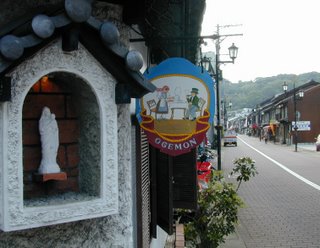
*Please note that the Japan on Foot book and the Japan on Foot blog are *not* the same. The book is far better.
WILLIAM ADAMS is reported to be the first Englishman to have set foot on Japanese soil. The pilot of the Dutch ship the Liefde sailed into the eye of a storm and, his vessel disabled, put ashore at Bungo (present-day Usaki city, in Oita prefecture) on April 19th, 1600. Shortly afterwards, Adams and his sick crew were incarcerated at Osaka Castle on the orders of the powerful warlord and soon-to-be shogun Tokugawa Ieyasu. Portuguese priests had spread wild allegations that Adams was the captain of a pirates’ vessel. Adams may not have got off to a good start in Japan, but his situation improved after lengthy questioning from his captor. Ieyasu had tired of the petty intrigues of the Jesuit missionaries, but he was impressed by the frankness and worldly knowledge of the Englishman. Much to the chagrin of the Portuguese and Spanish, Ieyasu appointed Adams to be his diplomatic and trade adviser. In 1604, the shogun ordered Adams to build a western-style sailing ship at Ito, on the east coast of Izu peninsula. Satisfied with the eighty-ton vessel, the shogun then ordered an even larger ship, of 120 tons, to be constructed. Adams was graciously rewarded for his efforts, receiving first a large house in Edo (now Tokyo), and then two swords that would transform the simple Will Adams into Miura Anjin, a samurai. Adams was warned that he would never be able to return to his homeland. Ieyasu told him that Will Adams was dead; that only Miura Anjin lived, and therefore the marriage between Adams and his wife in Kent was annulled. Now, with his own fief at Hemi, within the boundaries of present-day Yokosuka City, and a handsome stipend, Anjin was in the position to marry Oyuki, the daughter of a noble samurai. His Japanese wife bore him a son, Joseph, and a daughter, Susanna, but Anjin found business taking him further and further away from home as he regularly sailed off on trade missions to Okinawa and China. Anjin also became preoccupied with helping the Dutch and the British set up trading posts at Hirado, an island off the shores of Nagasaki. The Englishman died on Hirado in May, 1620. He was fifty-seven. Hirado specialities such as gobomochi and kasudosu cakes, as well as elegantly wrapped rice crackers are the delights being traded these days at Cake Shop William, a popular souvenir store on the English Trading Residents Street on Hirado. Etsuko and I peered through the shop’s window at the delicacies, wondering what Adams would make of all this, particularly the fact that the cake shop in his name stands on the site of the house where he drew his last breath. A short stroll from Cake Shop William brought us to what the tourist literature says is Adams’s tomb, but it was only after comparing the English and Japanese blurbs on the nearby placards that it became clear that the actual whereabouts of the English samurai’s grave is unknown. In true Japanese spirit the tomb we were looking at was nothing more than a testament to the ethos that you should never let the facts ruin Japanese history, and certainly not when it’s an excuse to construct another tourist attraction. I wondered how much more of the life of the romantic, English samurai might be pure fabrication. A plaque by Adams’ pseudo-tomb explains that to commemorate his four hundredth birthday, a stone had been brought from the grave of Mary Hyn Adams, his English wife in Kent. The stone had been placed on his tomb so that "finally, their two spirits could be reunited."
Grave Concerns
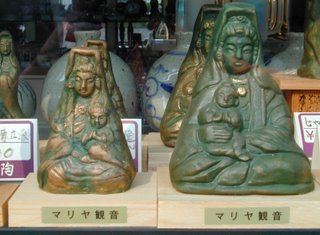
ALL PHOTOS BY JAPAN ON FOOT 2001/2002
A BENT-OVER old woman was tending to graves at Neshiko cemetery, arranging colourful flowers in a vase and pouring out small cups of tea to appease the souls of her ancestors. "I come here every day," she told Etsuko.
"There are nine graves to look after; it’s a lot of work but I’m hoping soon to have all my ancestors put together in one tomb, in true Buddhist tradition," she laughed. Etsuko and I had been struck by this cemetery on Hirado Island, as it differed from any other cemeteries we’ve seen in Japan. There were very few large tombs; mainly humble-looking graves covered with slate-like slabs that were gaily decorated with an abundance of flowers. It reminded us of cemeteries we had seen during travels through Chile, Bolivia and Peru, except that here not one single cross was in sight. We had decided to take a stroll around Neshiko after spending the morning at Hirado City Christian Museum. There, we had viewed various religious icons of the island’s Kakure Kirishitan (Hidden Christian) community and it had been explained to us that while the statues on display might look like Kannon Buddhas, they were, in fact, representations of Saint Mary. A basket of fish, we were told, symbolized Christ as a fisherman of men’s souls, and crosses hidden on the ornaments were obvious signs of the ornaments having been Hidden Christian icons. Crucifixes on chains, rosaries, bronze figurines and minute pieces of fabric tucked away in small metal cases, as well as porcelain bowls used for Kirishitan rituals were among items we viewed at the museum. Many of the artifacts had been hidden away for generations; the Christian community ever fearful of persecutions and long traumatized by the island’s history of martyrs who had been crucified on the shores of Neshiko, leaving behind a sea of blood. The middle-aged woman working at the Kirishitan museum denied that any Hidden Christians now lived on Hirado. "I believe only Ikitsuki Island has any Hidden Christians these days. Certainly, people in Neshiko won’t talk about it, they’re a tightlipped bunch here. Not even Shusaku Endo could find out anything when researching Hidden Christian history for his book Chinmoku (Silence)," she earnestly told us. But the previous day, while at Hirado Tourist Museum, we had heard that pockets of Hidden Christians still do exist on Hirado, and mainly out near Neshiko. The curator had blushed when I had inquired how many Hidden Christians might still exist on the island. “I think only the town hall could tell you that, but it might be a problem revealing such figures. We have a dowa problem here,” she added, referring to the buraku, a segment of Japanese society who have long suffered prejudice and continue to fight for equal rights to this very day. But, as regards the Hidden Christians, it had been to the chagrin of the Roman Catholic Church that many had refused to return to the fold of the mainstream church, even well after the Christian prohibition laws were abolished in the mid-nineteenth century. Many Hidden Christians were unwilling to give up a tradition of ancestor worship, they also feared possible future persecution from the Japanese government, and some of the community simply had reservations about a Westernized Christianity that appeared loud and flashy to them. Those who did not return to the fold of the Roman Catholic Church became known as Hanare Kirishitan (Separated Christians), a "lost flock" that embraced clandestine rituals, a bizarre iconography and beliefs that blended Catholicism, Buddhist cosmology and Japanese fables. In their holy book, "Tenchi Hajimari no Koto" (The Beginning of Heaven and Earth), the Virgin Mary is portrayed as a shamaness closely associated with the sun. And, during Otaiya, the Hidden Christian Christmas that starts on Dec. 23, this "lost flock" recalls a unique nativity story, one in which Maruya (Mary) is thrown out of her parents’ home after becoming pregnant to give birth in a country called Beren. Commonly known as the "Tenchi," the bible of the Hidden Christians says that three kings from Turkey, Mexico and France visited Mary in the stable at the time of Christ’s birth. However, with the younger generation moving out to the big cities, the influence of television as well as all the other trappings of modern society, the traditions of Japan’s Hidden Christians are dying.
***
The little old lady at the Neshiko cemetery invited Etsuko and me back to her home for tea and a chat. A small kamidana (Shinto shrine) adorned a corner of the living room of the house where eighty-year-old Mrs. Kuni Tsuji lives with her son and daughter-in-law. There was nothing to suggest that the family had once been Christian, but it turned out that Mrs. Tsuji’s ancestors had been among the first to convert to Christianity on Hirado. On hearing that my name is Mary, the old dear’s eyes lit up and she gave me a tender pat on the knee. "Maria," she swooned apologetically, "we no longer keep our traditions. Twenty years ago we became members of the local Soto Buddhist temple, but my eldest son, like his father became the chokata (highest-ranking member), learning the orassho (latin: oratio) and saying the prayer at three of our Otaiya festivals," she explained. The Hidden Christian community, Mrs. Tsuji told us, would meet each year for prayers on a site just behind the Kirishitan museum. The men would pray together while the women prepared food. Mrs. Tsuji explained that she herself was not familiar with the prayers or rituals. "Women weren’t allowed to see them. Apparently, once a bride from outside the village had discovered that the family she married into here was praying to Saint Mary. She informed somebody and the whole family was massacred. After that, women weren’t trusted to learn anything of the religion," she said. Etsuko asked her if she still kept any Christian items. "We no longer have the takaramono (treasures). Only my son, the carpenter and me know where the treasure is hidden," the old dear whispered as if divulging snippets of the most sensitive information. Etsuko and I couldn’t resist laughing. Why in this day and age did Mrs. Tsuji feel she had to hide the family’s Kirishitan icons? Might it not be better to hand them over to the museum? The old woman looked horrified at the suggestion. "The treasure has been in my family for many generations; it was given to my ancestors by European priests who came here. In exchange, my family would give the foreigners a cow because they liked to eat beef," she said in defence. "What is your treasure?" I asked, realizing that whatever it was, it still held incredible power over the old woman’s mind. Mrs. Tsuji gasped in shock at my question. "I can’t tell you that," she snapped, "it’s a secret." But never being one to give up so easily, I pursued the topic. "Is your treasure a Saint Mary?" I gently inquired. The old woman jumped out of her skin, and started to tremble with fear. "You shouldn’t ask that question ever; it’s takaramono," she snapped again. "The treasure is now hidden and only three of us know where it is. But the next time you visit I will tell you more secrets of the Hidden Christians in Neshiko, as well as about the komugi-sama (wheat god) that came from Korea," she proffered as she saw us off with a little bow at the door.
Mrs. Tsuji’s daughter-in-law, Shizue, volunteered to point out a tree we had heard bleeds the blood of Neshiko’s Christian martyrs. As we strolled out down a winding country lane, passing paddies that glinted in the late afternoon sun, Shizue, 43, told us that she had known nothing of Hirado’s Hidden Christians, let alone the massacres at Neshiko, until her child came back from school one day and told her. "I was never taught any of this history when I was at school, I knew absolutely nothing about the Christians here yet I have lived in Neshiko all my life; that’s how secretive the community was. And, it was a surprise for me to learn that my husband’s family had been considered the most important Christians on Hirado, that they were the ones responsible for leading prayers and carrying out such rituals as baptism," she explained to us. "As for the tree, I’m not sure what I believe about it, but one day my son rushed home in tears, saying that he had been tearing at the bark with a stick when the tree had suddenly started to bleed," Shizue added as Etsuko and I peered up at the gnarled boughs of the huge, old tree.
Ave Maria
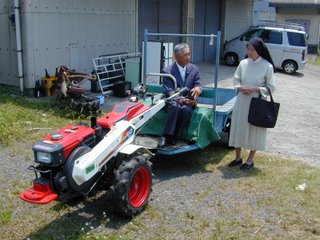
ALL PHOTOS BY JAPAN ON FOOT 2001/2002
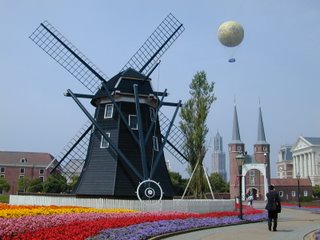
And, beyond even being a resort, Huis Ten Bosch is also home to a good many Japanese who have purchased Dutch-style houses in Wassenaar, a settlement on a hill that overlooks the park. We spent a couple of days reveling in the theme park’s attractions and viewing the houses in Wassenaar, which have price tags ranging from thirty-five to eighty million yen. Then, we hit the hot asphalt once more, traipsing up and over mountain roads, in the direction of Nagasaki City. I was stunned by the features of the middle-aged woman in the grocery store in Okushi hamlet, Seihi town. I had popped in to buy a bottle of wine for the night, and while handing over my money, I was struck by the fact that she looked more southern European than Japanese. She was a gorgeous, albeit rather mature, Carmen who looked extraordinarily out of place in the small, dusty shop, which sold little more than a mix of detergents, pink rubber gloves, clothes’ pegs and an assortment of snacks that all seemed to have passed their sell-by date. The woman asked me my name, and for the umpteenth time since arriving in Nagasaki prefecture, eyes glazed over in wonderment. "Tokyo was not part of her mother’s agenda for her. She didn’t appear disappointed about what lay in the cards for her: a life of helping out at the family store and one day caring for a husband and raising children. I smiled at the thought that she could be content with her lot in life, disguising the incredible sadness I truly felt for this young woman whose talents were destined to go to waste. "But what brings you here?" Chie chirped up after being well applauded for her performance, and so I explained about the walk, and how Etsuko and I were now en route to the museum dedicated to Shusaku Endo, the Christian novelist famed for such great works as Chinmoku (Silence). The mother rubbed her hands in glee, telling me that she knew Endo’s wife well and met with her every year in Sotome. "But we are Buddhist, you understand?" Chie emphasized again, making me wonder if they thought I had purchased the wine to perform some holy sacrament. "We have a lot of problems here," her mother butted in. "This is a very strange village. We have three Buddhist temples here," she added, biting her lip nervously. I started to wonder if the family had once been Christian, and what might be the problems with the temples, but I felt it might be unwise to pursue the subject. "So, have you read Chinmoku?" enthused Chie’s mother. I explained that I had, but more than a decade ago and that I planned to buy another copy in Nagasaki. On hearing this, the young woman and her mother leaped towards the backdoor, screaming out for grandmother. "Grandma, bring the Chinmoku!" they repeatedly yelled although I told them it wasn’t necessary as I intended to read it in English. "Please take grandma’s Chinmoku," Chie pleaded, "it would give us great pleasure," she continued as a frail, old woman hobbled forth with a copy of the novel about the persecution of Kyushu’s Christians and of two Portuguese apostates. Grandma wiped a tear from her eye as she carefully unwrapped the novel from its silk wrappings in a box, and took out a pink rosary. Turning to a page in the well-thumbed book, the old dear’s lips quivered as she read a passage aloud. Silence fell over the little shop and I only wished that I could have understood the part she was reading. The silver-haired dear smiled softly when I explained that it was better for her to keep the book; that I would read it in English. And then, to the strains of "Ave Maria," I found myself waving goodbye to Chie, her mother and grandma. Dusk had fallen, and as I strolled back along the narrow, dimly-lit street to the guesthouse, I wondered what had been the significance of the passage read to me, and if Chie was truly content with the life plan that her mother had for her.
Mammoth Undertaking

ALL PHOTOS BY JAPAN ON FOOT 2001/2002
Valley of the Gods

ALL PHOTOS BY JAPAN ON FOOT 2001/2002
The average Joe Soap, Mary King or Shimabukuro Etsuko is not allowed to venture out to Amanoiwato Cave, but we did stroll out to another cave along the same river where it is believed all the gods gathered to discuss how they could lure Amaterasu from her cave and thus restore light to the world. Apparently, the goddess Ameno Uzume performed a lewd dance in front of the cave, waving her genitals at all the gods, who creased up with mirth at the wild spectacle. Becoming curious about the commotion, Amaterasu peeked outside her cave only to catch a glimpse of her face in a mirror.
Takajiro, a god of enormous strength, then pulled back the boulder covering the mouth of the cave and together, the gods pulled Amaterasu back into the world. In Saito Cty, also in Miyazaki prefecture, we strolled out through an area that is dotted with more than three hundred ancient tumuli—a verdant area that is Japan’s equivalent of the Valley of the Kings and Queens. The sun was a bloodshot eye as it drifted below the horizon after we had spent an arduous day traipsing out of Miyazaki City. Out in Futo hamlet, Etsuko and I found ourselves without accommodation for the night. Kipping out on the beach had all felt very romantic at the time. "How lovely it would be to sleep under the stars," Etsuko had said to me. "Yes, indeed," I had oozed. How idyllic to spend the night listening to the soporific lapping of waves and feeling the gentle sea breeze on our faces as we lay tucked in our sleeping bags. Surely, nothing could be more beautiful. But neither of us would grab more than the odd wink or two of slumber that night. Miyazaki’s mosquitoes viewed us as a potential banquet and as they pursued their kamikaze conquest, Etsuko and I tossed around in misery, waving frantically to protect ourselves from their savage attacks. Before the sun had even risen, we were back on the road, completely exhausted from the nightlong battle and covered in a mass of huge, incredibly itchy pink bites. With our pedometers having now hit just over seven thousand kilometres, we continued on down the coastline, stopping off for a few hours at Sun Messe Nichinan, a park that has not only attempted to recreate Easter Island with its Moai statues, but has also taken a stab at recreating its own version of England’s Stonehenge. The stone circle was a rather sad affair to say the least, but the Moai were an uncanny experience for both of us, reminding us of the one thousand or so statues we had seen some eight years before out on what is reputed to be the world’s most remote inhabited island. In fact, it was during our time on Easter Island, which lies 3,600 kilometres away from the South American coastline and Chile under whose jurisdiction the island falls, that we bumped into a Signor Martin, an elderly gentleman who had startled us with the fact that his grandfather hailed from Okinawa. As we tucked into a plate of cerviche, a delicious South American speciality of raw tuna marinated in vinegar and lemon, Signor Martin had been unable to conceal his excitement on discovering that Etsuko originates from Japan’s most southern prefecture. He then went on to regale us with the story of how his grandfather had been swept up on the shores of Easter Island, fairly well on the brink of death. "He was a tuna fisherman and with the rest of his crew was lost at sea for weeks, perhaps even months," said Signor Martin. "He was pretty well near dead by the time he landed on this speck of an island, but my grandfather stayed, married a local woman and never went back to Okinawa. He died when I was a small child, but I remember that he spoke with great love for his homeland," Signor Martin had told us, impressing upon us the fact that no island is ever truly an island; that nowhere in the world has ever been isolated, unknown or free from outside and far flung influences.
Onwards to Okinawa
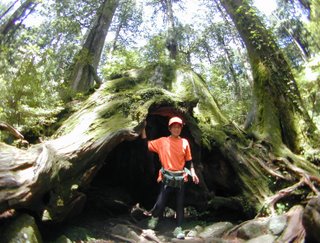
YAKUSHIMA MARKED the end of our walk through Kyushu. This island that lies off the southern tip of Kagoshima prefecture has been designated a World Heritage Site for its unique flora and fauna. Despite threat of rain—apparently, there’s invariably a downpour up in the mountains—it turned out to be a hot muggy day as Etsuko and I found ourselves clambering over lichen and moss-covered rocks out in this veritable fairy-like world. We spotted deer scampering and snuffling in the bushes; groups of macaque monkeys swung without a care through the tendril-like branches of the great Yaku sugi (Japanese cedar) trees for which the island is renowned, and even a snake didn’t flinch as we approached it; instead it nonchalantly slithered past our feet. Taking tentative steps along precarious tree trunks that span the forest’s gurgling rivers and streams, we spent a day hiking up to the largest Jomon-period sugi—a cedar estimated to be between 2,600 and 7,200 years old that also boasts a whopping girth of 16.4 metres. A late lunch was taken at Wilson’s Stump, where we observed in wonder the grotto-like grandeur of this huge cedar trunk, some 4.39 metres in diameter, inside of which tourists had huddled to peer up at the shafts of sunlight that beamed down upon a small Shinto shrine. With hishaku (wooden shrine ladle) in hand, Etsuko and I scooped sweet mountain water from a stream that trickled through the trunk of the tree and refreshed ourselves before clambering on up to Takatsuka Hut, where we planned to bed down for the night. Deer nervously twitched and sniffed at the curry-essence air as Etsuko and I sat under the stars, slurping our spicy Cup Noodle dinners. The following day, we returned to Wilson’s Stump in time for a late picnic-breakfast.
Named after the botanist who found it, Wilson’s Stump is said to be the remains of a tree that was cut down on the orders of the sixteenth-century warlord Toyotomi Hideyoshi. Apparently, the wood was used for the construction of a building to house a great Buddha statue at Hoko-ji temple in Kyoto. This part of the forest is a truly magical place and I was only grateful that we had at least five minutes of it alone to soak up its spiritual serenity before a horde of a hundred or so camera-toting tourists clumped on through. We packed up and continued with our descent, leaving the horde to continue with what looked like a never-ending rigmarole of setting up victory-V group shots. The Queen Coral 8 spirited us out through the choppy blue waters of Kagoshima Bay. Fangs of water clawed at the side of the ship as we rocked, heaved and rolled out into deeper waters until the speck that was Kyushu had completely disappeared from view. Like many other passengers, Etsuko and I lay groaning and moaning on our futon, turning green at the gills and hoping that the motion sickness tablets would soon knock us out. Typhoons had been lashing Japan’s shores for more than a month now, and yet another was on its way. It was with huge relief that—twenty-four hours later—Etsuko and I finally staggered off the ship at Motobu Port. We breathed in the salty, sea air and saluted the direction of Japan. A lump welled up in my throat and I started to choke on tears. We were now approaching the end of our walk; a journey that had already surpassed the fourteen-month mark and a foot-slog of more than 7,300 kilometres that had taken us from a windy, freezing northern outpost of Hokkaido to the northern shores of Okinawa. It had been an exhilarating and exhausting adventure and it would shortly end on Yonaguni Island. We both felt that the walking, freedom and challenges had become an integral part of our daily lives, and it had reshaped who we are and what we value. Biting back tears, Etsuko and I tugged our trolleys along the asphalt road and into Motobu town. The gregarious strumming of an Okinawan sanshin drifted towards us from afar, as if carried by a messenger on the early evening breeze.



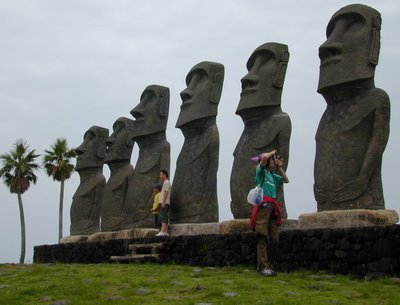
No comments:
Post a Comment